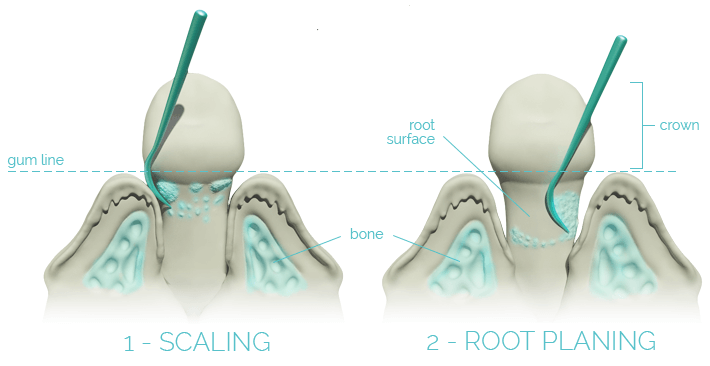What is it?
Scaling and root planing is the most common and conservative form of treatment for periodontal (gum) disease.
Scaling is the removal of calculus (commonly called tartar) and plaque that attach to the tooth surfaces. The process especially targets the area below the gum line, along the root.
Plaque is a sticky substance, full of bacteria, that forms on teeth. When plaque hardens over time, it is called calculus.
Plaque is more likely to stick to rough surfaces. For this reason, the root surface is made smooth in a process called root planing. Root planing removes any remaining calculus and smooths irregular areas of the root surface.

It’s used for?
Bacteria cause periodontal disease. Plaque and calculus provide an irregular surface that allows these bacteria to attach easily. Scaling and root planing are done to remove the plaque and calculus. For early stages of the disease, this treatment may be all that is needed to get the condition under control. This is especially effective with gingivitis. With more advanced gum disease, scaling and root planning may be the first step before surgery.
Preparation
For some patients, scaling and root planing can cause discomfort. A local anesthetic may be used to numb the portion of your mouth that is being worked on.
How it’s done
Scaling and root planing are done with a combination of ultrasonic scalers and hand instruments. Ultrasonic instruments are electric or air-powered. They have two components:
- A relatively dull metal tip that vibrates at a very high frequency and “knocks” plaque and calculus off the tooth
- A water irrigation system that cools the tip and helps to flush out debris from around the teeth
Hand instruments are not powered. They have cutting edges that we uses to chip away plaque and calculus.
These instruments come in various shapes and sizes. Different instruments are used for different teeth, and even for different surfaces of the same tooth.
Typically, ultrasonic instruments are used first to remove large deposits of plaque and calculus from the crowns and roots of the teeth. Hand instruments called scalers and curettes are then used to remove any remaining material and make sure that the tooth surface is clean and smooth. When working under the gum line, we cannot see the plaque or calculus. He or she will rely on the sense of touch to feel for roughness on the root surface.
Sometimes, scaling and root planning can be completed in one visit. This usually is possible if you have gingivitis, the earliest stage of gum disease. However, if you have periodontist, multiple visits are usually needed. The periodontist typically will do one-quarter of your mouth (a quadrant) at each visit.
Follow up
For two to three days after the treatment, you may have some soreness and be sensitive to hot and cold temperatures. Over-the-counter pain relievers can help.
You may be asked to use an antiseptic mouth rinse after scaling and root planing. This is especially likely if your gums are very sore. However, you should continue brushing and flossing as usual. You can expect some minor bleeding in the first days after scaling and root planing. This usually stops within a week.
Risk
Treating periodontitis decreases gum inflammation. It also eliminates periodontal pockets, which can trap plaque. Therefore, if treatment is successful, the swelling will be gone and your gums will shrink or recede.
The extent of shrinkage depends on the initial depth of the pocket and the severity of periodontitis. The more severe the disease, the more your gums will recede after successful therapy. As a result, some part of the root is exposed. This makes the tooth look longer. It also will be more sensitive to heat and cold. To prevent root cavities, your dentist may prescribe a fluoride-containing gel. It’s also important to control plaque.
When to call us?
If you develop a fever or a lot of bleeding, pain or swelling after scaling and root planning, contact us.
A periodontist is a dentist who specializes in the prevention diagnosis and treatment of periodontal disease root planing procedures
